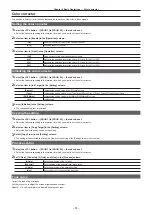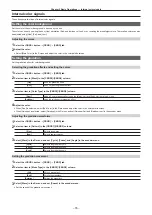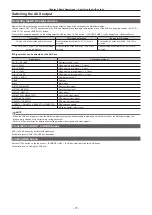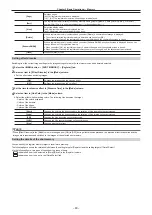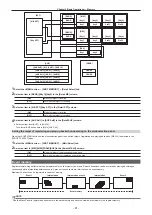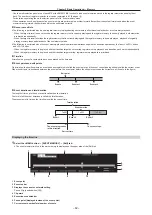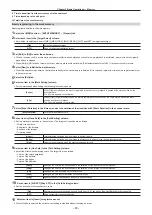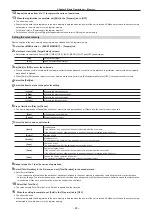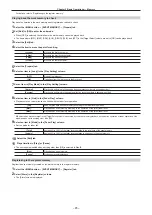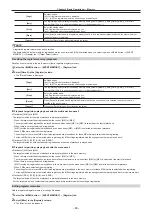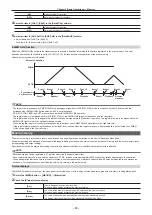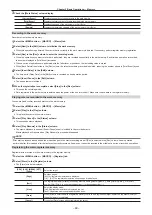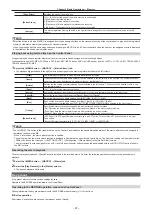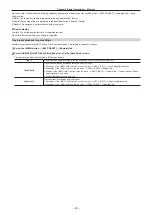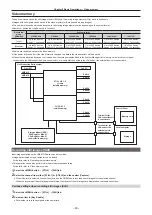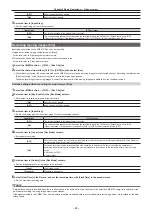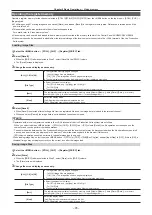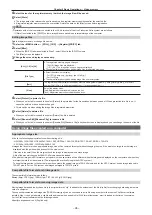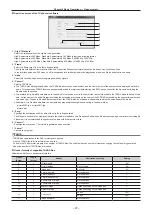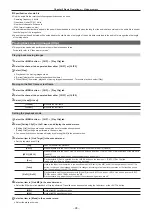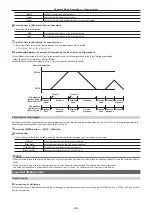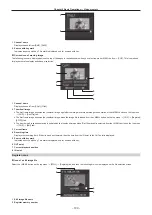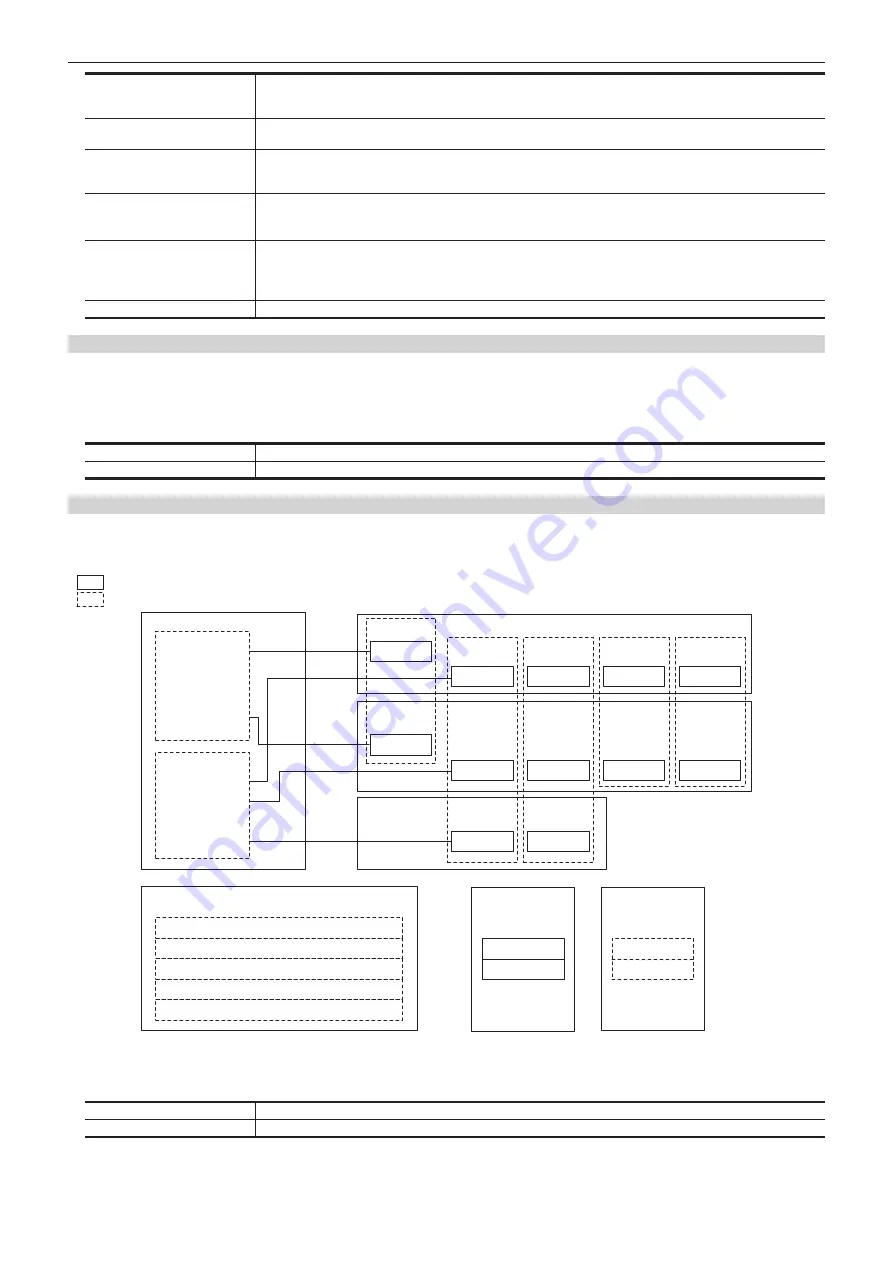
– 87 –
Chapter 5 Basic Operations — Memory
[Page]
Switches pages.
[ALL]: All registered memories are displayed.
[1-X] - [9-X]: The registered memories on each page are displayed.
[Sort]
The registered memory display is sorted by memory name ([Name
+
]/[Name
−
]), date ([Date
+
]/[Date
−
]), or memory
number ([No
+
]/[No
−
]), in either ascending order (
+
) or descending order (
−
).
[View]
Select the display mode.
[List]: Registered memories are displayed in a list.
[Icon]: Registered memories are displayed as icons.
[Delete]
When a registered memory is selected and you select [Delete], a confirmation message is displayed.
f
The currently selected registered memory is deleted when you select [OK].
f
When you select [Cancel], the registered memory is not deleted and the confirmation screen is closed.
[Rename EMEM]
When a registered memory is selected and you select [Rename EMEM], a keyboard screen is displayed and you can
change the name of the registered memory.
f
When you select [OK], the registered memory’s name is changed and the keyboard screen is closed.
f
When you select [Cancel], the registered memory’s name is not changed, and the keyboard screen is closed.
[Close]
Closes the [Misc] screen.
Setting the operation of the multi-selection panel area
Specify the operation when a register memory is selected with the <EVT MEM> button in the multi-selection panel area.
1
Select the <MEM> button
→
[EVENT MEMORY]
→
[Register] tab.
2
Select an item in [Direct/Next] in the [Play Setting] column.
[Direct]
Plays back the image when the register memory is selected.
[Next]
Plays back the image when the [PLAY] ] is selected after the register memory is selected.
Setting details of event memory
You can specify the register memory target to recall more precisely.
The following figure shows the relationship between the setting target of [Register] and the setting target of [Detail Select].
f
In the following figure, two types of lines show the types of items.
indicates an item to be selected in [Store]/[Recall] in the [Register] column.
indicates an item to be set in the [Detail Select] tab.
[ME1]
[DSK]
CBGD1
CBGD2
[XPT]
Key1
Key2
[Key XPT]
[A/B XPT]
[CBGD]
BKGD
[BKGD]
[Key1]
[Key2]
[ME2]
Key1
Key2
BKGD
[BKGD]
[Key1]
[Key2]
Key1
Key2
[Clip1]
[Clip]
[Clip2]
[AUX Sel1]: [All], [AUX1] - [AUX16]
[AUX Sel2]: [AUX1] - [AUX16]
[AUX Sel3]: [AUX1] - [AUX16]
[AUX Sel4]: [AUX1] - [AUX16]
[AUX Sel5]: [AUX1] - [AUX16]
[AUX]
[Key3]
[Key4]
PinP1
PinP2
[Key3]
[Key4]
PinP1
PinP2
1
Select the <MEM> button
→
[EVENT MEMORY]
→
[Detail Select] tab.
2
Select an item in [BKGD]/[Key1]/[Key2] in the [Detail ME] column.
[ON]
Made the target for recalling.
[OFF]
Not made the target for recalling.
3
Select an item in [A/B XPT]/[Key XPT] in the [Detail XPT] column.
Summary of Contents for Live Production Suite Series
Page 5: ...Please read this chapter and check the accessories before use Chapter 1 Overview ...
Page 11: ...This chapter describes installation and connection Chapter 2 Installation and Connection ...
Page 50: ...This chapter describes menu operations Chapter 5 Basic Operations ...
Page 113: ...This chapter describes the configuration of operations Chapter 7 Configuring Operations ...
Page 122: ...This chapter describes how to operate system menus Chapter 8 System Menu ...
Page 136: ...This chapter describes plug in functions Chapter 9 External Interfaces ...
Page 140: ... 140 Chapter 10 Specifications Dimensions Dimensions of the XPT Unit AV LSX10 Unit mm inch ...
Page 141: ... 141 Chapter 10 Specifications Dimensions Dimensions of the ME Unit AV LSM10 Unit mm inch ...
Page 153: ...This chapter describes the setting menu table and terms Chapter 11 Appendix ...
Page 176: ...Web Site https www panasonic com Panasonic Corporation 2020 ...


